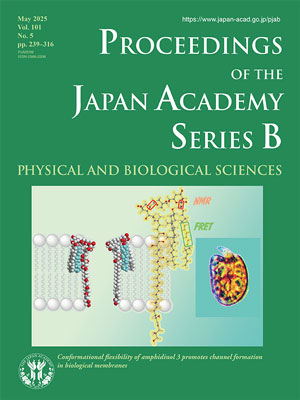About the Cover
Vol. 101 No. 5 (2025)
This review by Murata et al. (in this issue, pp. 249–273) explores marine natural products whose conformational flexibility enhances biological activity. Research on ciguatera, a type of seafood poisoning, has been actively pursued by Dr. Takeshi Yasumoto (Professor Emeritus, Tohoku University), a member of the Japan Academy. Many compounds discovered in this research are structurally diverse polyketides, some of which exert potent biological activity by interacting with biological membranes.
In particular, the authors focus on amphidinol 3 (AM3), which, as shown on the cover, is a natural product with a long carbon chain produced by the dinoflagellate, a unicellular alga (Amphidinium klebsii shown on the right). AM3 shows strong antifungal activity by forming an ion-permeable channel in the sterol-containing cell membrane (shown in blue). The review details how the AM3-sterol channel structure was elucidated through stereochemical assignment, conformational analysis, and total synthesis. By employing both solution and solid-state nuclear magnetic resonance (NMR), they simultaneously determined the configuration and conformation of AM3, ultimately revealing its functional structure within membranes. For example, the NMR data (especially the spin coupling constants) indicate that the parts shown in red boxes are hinge regions, where rotation of these bonds changes the conformation and AM3 adopts a hairpin shape in membranes. In addition, the proximity of the conjugated double bonds (polyene part, shown in the green box) to cholesterol was confirmed by fluorescence resonance energy transfer. Furthermore, the structure-activity relationship in channel formation was investigated using chemically synthesized AM3 analogs. As a result, both the hydrophobic polyene part and the hydrophilic polyol part of AM3 bind stably to the lipid bilayer by interacting with sterol in the cell membrane, leading to assembly of the AM3-sterol complex into a functional ion channel.
These findings are expected to accelerate research into the interactions between bioactive molecules and lipids/sterols in cell membranes. By accurately predicting the functional structures of natural products in biological environments, the structural information will not only help elucidate the mechanisms of action of natural products and drugs but also contribute to chemical biology approaches and a deeper understanding of cellular functions.
Keisuke Suzuki
Member of the Japan Academy




